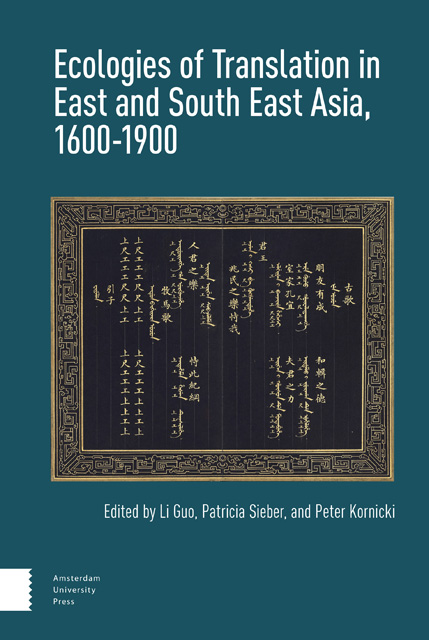Book contents
- Frontmatter
- Table of Contents
- Introduction: Scriptworlds, Vernacularization, and Shifting Translation Norms
- 1 On Not Being Shallow: Examination Essays, Songbooks, and the Translational Nature of Mixed-Register Literature in Early Modern China
- 2 A Faithful Translation: Tsūzoku sangokushi, the First Japanese Translation of Sanguozhi yanyi
- 3 Romance of the Two Kingdoms: Okajima Kanzan’s Chinese Explication of ‘The Annals of Pacification’ (Taiheiki engi)
- 4 Speaking the Sinitic: Translation and ‘Chinese Language’ in Eighteenth-Century Japan
- 5 ‘Body Borrowed, Soul Returned’: An Adaptation of a Chinese Buddhist Miracle Tale into a Vietnamese Traditional Theatrical Script
- 6 ‘Out of the Margins’: The Western Wing Glossarial Complex in Late Chosŏn and the Problem of the Literary Vernacular
- 7 Vernacular Eloquence in Fiction Glossaries of Late Chosŏn Korea
- 8 Imagined Orality: Mun Hanmyŏng’s Late Nineteenth-Century Approach to Sinitic Literacy
- 9 Linguistic Transformation and Cultural Reconstruction : Translations of Gorky’s ‘Kain and Artem’ in Japan and China
- Index
4 - Speaking the Sinitic: Translation and ‘ChineseLanguage’ in Eighteenth-Century Japan
Published online by Cambridge University Press: 16 November 2022
- Frontmatter
- Table of Contents
- Introduction: Scriptworlds, Vernacularization, and Shifting Translation Norms
- 1 On Not Being Shallow: Examination Essays, Songbooks, and the Translational Nature of Mixed-Register Literature in Early Modern China
- 2 A Faithful Translation: Tsūzoku sangokushi, the First Japanese Translation of Sanguozhi yanyi
- 3 Romance of the Two Kingdoms: Okajima Kanzan’s Chinese Explication of ‘The Annals of Pacification’ (Taiheiki engi)
- 4 Speaking the Sinitic: Translation and ‘Chinese Language’ in Eighteenth-Century Japan
- 5 ‘Body Borrowed, Soul Returned’: An Adaptation of a Chinese Buddhist Miracle Tale into a Vietnamese Traditional Theatrical Script
- 6 ‘Out of the Margins’: The Western Wing Glossarial Complex in Late Chosŏn and the Problem of the Literary Vernacular
- 7 Vernacular Eloquence in Fiction Glossaries of Late Chosŏn Korea
- 8 Imagined Orality: Mun Hanmyŏng’s Late Nineteenth-Century Approach to Sinitic Literacy
- 9 Linguistic Transformation and Cultural Reconstruction : Translations of Gorky’s ‘Kain and Artem’ in Japan and China
- Index
Summary
Abstract
In the beginning of the eighteenth century,Japanese scholar Ogyū Sorai promoted translationstudy (yakugaku).This study advocated a ‘direct translation’ methodto render Chinese texts into everyday Japanese, tocounter the fundamental problem of the kundoku (reading by gloss)method: its paradox of being a translation yetconcealing its translational nature. To promotedirect translation, Sorai encouraged reading andunderstanding Chinese texts in their own acousticand grammatical forms, which he called ‘Chineselanguage’. Sorai's ‘Chinese language’ and itspractice, the tōwa(contemporary spoken Chinese) study, epitomize thepre-1900 Sinitic concept of ‘language’. Thiswriting-imbued ‘Chinese language’ manifested thevitality of Sinitic writing and the intricaterelation of voice and text, as well as of Chinaand the Sinitic.
Keywords: translation, Chineselanguage, literary Sinitic, kundoku, Ogyū Sorai
Introduction
In 1714-1715, the renowned Japanese Confucian scholarOgyū Sorai 荻生徂 徠 (1666-1728) published Yakubun sentei 譯文筌蹄 (A Tool for Translation,editor's note 1711), an aid for Sinitic studies. Inthe ‘Prefatory Remarks in Ten Principles’ (Daigen jussoku 題言十則) to thiswork, Sorai offered his views on ‘Chinese language’(Chūka gengo中華言語):
此方自有此方言語。中華自有中華言語。體質本殊。由何吻合。是以和訓迴環之讀。雖若可通。實為牽強。而世人不省。
This land [i.e., Japan] has its own language, andChina has the Chinese language. The forms andnatures of the two languages are fundamentallydifferent; how can we unite them? When we approachthe problem by using Japanese glossing and theinverted word order to read, it may seemcomprehensible, but it is quite distorted.However, people nowadays are not aware [of thisdistortion].
What did Sorai mean by ‘Chūkagengo’? Both the term gen and the term go suggest a spokencomponent. The character gen 言 (Ch. yan) stresses spoken words and go 語 (Ch. yu) means words to state orto conversate. The supposed written traces of thevanished spoken words are also called gen or go. By using gengo rather than bun 文 (Ch. wen; pattern, writing, composition),Sorai was emphasizing speech rather thanwriting.
- Type
- Chapter
- Information
- Ecologies of Translation in East and South East Asia, 1600-1900 , pp. 109 - 144Publisher: Amsterdam University PressPrint publication year: 2022

